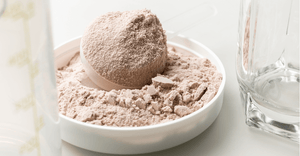The 5 Best Forearm Exercises: Break Down Fibres & Build Size
Many athletes overlook the importance of having strong forearms. And even more importantly, a lot don't train them properly.
Maybe you've been trying very hard to get them to grow, but it's just not happening.
If you want to start effectively training your forearms, or perhaps you're struggling to get them to grow, check out our top 5 best forearm exercises for mass.
Why You Should Train Your Forearms
Not training your forearms will result in underdeveloped grip strength. Strength is one of the main functions of this muscle group.
You might think: I do not need grip strength; I want to get new muscle mass.
Well, it doesn't work that way. Having weak forearms can cause problems with performing specific exercises in the gym. Your forearms are used in almost every upper-body activity—for example, pull-ups, deadlifts, barbell curls, chin-ups but also with unracking weights.
For example: If you're doing a pull up on your back and biceps workout. You will notice that you're using your forearms, biceps, and back. If your forearms are weak, you will let go, and your back doesn't get trained enough to grow.
Using multiple muscles together is called the Kinetic Chain. If one of the muscle groups is weaker, you will not get enough training for the other muscle groups.
Not only will you be able to lift more weights or do more reputations. You will also have a more aesthetics pleasing look with bigger forearm muscles.
Especially for bodybuilding standards, it's essential to have symmetric looking forearms.
A recent study also showed that having weak forearm grip strength could be an indicator of having nutritional deprivation. Low grip strength in healthy adults could increase the risk of functional loss
In conclusion, training your forearms is essential for either grip strength, which will result in lifting more weights, aesthetics looks, and overall health.
How Does The Forearm Muscle Look Like
Before we go into detail, let's take a look at the muscle anatomy and the different uses of the forearms.
So, we already know that the forearms are very important for grip strength and could be a potential health marker.
The forearm muscles can be divided into three groups:
- Brachioradialis
- Flexors
- Extensors

The brachioradialis muscle is closely associated with the brachialis, which is mostly part of your biceps. When training your biceps, you will most-likely also activate your brachioradialis. When performing a bicep hammer or reverse curl, you will activate this muscle group, but also with a rowing exercise.
The flexor muscles are responsible for many different finger motions, for example, bending your fingers or wiggle your wrist.
The extensor muscle is the muscle you will activate while performing an exercise which requires you need to hold on lots of weights like farmer walks or deadlifts.
The 5 Best Forearms Exercises
First of all, we will show you the best forearms exercises for building muscle and grip strength.
It's crucial to perform all exercises below while training your forearms. When training these muscles, you must hit them on every angle possible. Just like you do with training chest and triceps, for example, you want to hit it all muscle fibers for optimal growth.
The exercises below are all safe, effective, and easy to perform in any gym or at home.
If you're a beginner, always make sure to train light. If you are unsure if you can perform these exercises, please contact your physician.
1. Reverse Barbell Curl
We will start off with a reverse barbell curl which will focus the brachioradialis and pronator trees. If you're doing this exercise for the first time you will notice that feels strange compared to the normal barbell curl.
The reason why we start with this exercise is that we will focus on the big and noticeable forearm muscles first.
A study showed that having a pronated grip resulted in more activation of the brachioradialis and was most efficient in not activating the bicep muscle.

The same movement can be done with dumbells, but it's essential to the same activation.
While performing this exercise it could be beneficial to add a resistance band. This will result in being heavier at the top of the curl. This is is exactly what you want because at the top you will have more forearm movement.
You can simply start with just the barbell and add weight over time.
This exercise could be replaced with a dumbbell hammer curl to ease the wrists.
2. Barbell Wrist Extention
The second exercise is a wrist extension focussed on wrist and forearms flexors. This exercise can be done with either dumbells or a barbell.
While performing this exercise it's important to start light because many underestimate the weights and strength they have.

You need to rest your elbows on the bench and go up and down with the barbell. After a couple of reputations, you will notice the effect on forearms.
When coming up, try to flex the forearms as hard as you can for optimal contraction.
3. Barbell Wrist Flexion
The third exercise is the complete opposite of the wrist extension exercise. It's focussed on the forearm flexors and can be done in different positions.
You can either do the exercise on a bench or you can do the standing wrist flexion with the barbell.
This exercise will really give you a good stretch and pump in the muscle.
We personally like to use the standing version because it gives an amazing stretch if you roll the barbell to the top of your fingers.


It's important to really get a good squeeze at the top to hit every muscle fiber.
I would recommend using an Olympic bar to start with and work your way up in weights.
4. Farmer Walks
This type of exercise is different than the others we covered because it's not necessarily targeting a specific forearm muscle.
This exercise is all about picking up and holding heavy weights for as long as you can.
Probably everyone has experienced the feeling after carrying heavy objects like grocery bags for a long period of time.
You feel your forearms being tested and will experience a muscle pump as well.
Farmer walks can be done with either dumbbells, kettlebells, or other heavy objects. It's also an excellent exercise for your trapezius, legs, and abdominals. Researchers found out that it possibly help strengthen your gluteus medius.

When performing farmer walks it's important to take heavy weights and keep walking until you can't anymore.
Because of the heavyweights, you will force your forearms to keep on going which will result in muscle growth over time.
5. Dead Hang
The last exercise is easy to perform but perfect for training your forearms.
The only thing you have to do is hang for as long as you can!
A good starting point would be 30 seconds and work your way up.
You could also add some weights by wearing a belt or a put a dumbell between your feet if it's to light.

The Bottom Line
Training your forearms is very important as it can help with increasing grip strength. This will help you with lifting more weights and thus more reputations.
The 5 best forearm exercises are:
- Reverse Barbell Curl
- Barbell Wrist Extention
- Barbell Wrist Flexion
- Farmer Walks
- Dead Hang
It's important that you perform most of these exercises for optimal results.
FAQ
How Often Should You Train Forearms?If you would like to improve your grip strength, it's advised to train your forearms at least 2-3 times a week. Some people like to train it more often; however, this depends on how much exercise you perform.
A study showed that there wasn't much of a difference in training 2-3 times or 4-5 times a week in grip strength.
When To Do Forearm Workout?It's best to do a forearm workout after your regular training. Some people like to do it after their back or pull day because you already activated your forearms and will be fatigued quicker.
When training it 2-3 times a week, it's advised to train it on your back or pull day.
You can also train your forearms on days you are working on weak points like the upper chest or side deltoids.
Can I Do A Forearm Workout Everyday?The short answer is: Yes, you can train them every day. It depends on how this affects your other workouts if you have constant muscle soreness.
Is it really effective?
One study tested this out and they concluded that it doesn't help with extra grip strength. If your goal is to increase muscle then it might be beneficial.
We recommend training it 2-3 times a week after your workout.
Does A Forearm Tool Work?Most tools that you see on the internet are perfectly acceptable for overall forearm strength to a certain degree. Most of them only target one part of the arm and not every muscle, which you need to improve fast and efficiently.
If you want to increase the amount of muscle or grip strength, you need to train it with heavyweights and frequently.
We would not recommend using these tools if you are one of those people.
But, these tools are perfect for people that need to heal from an injury or for the elderly.
I hope you liked our list of the best forearm exercises. Make sure to check out our other training guides:












Leave a comment